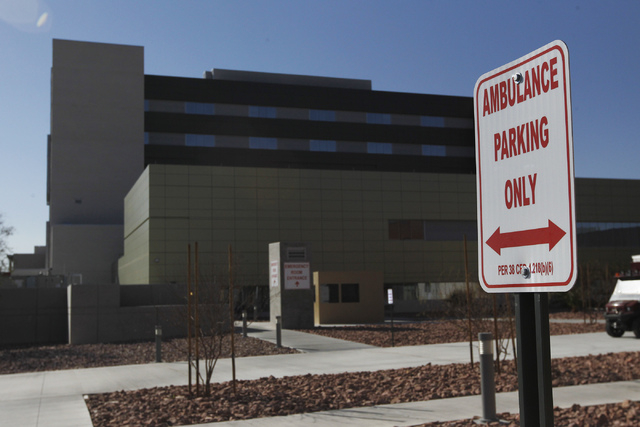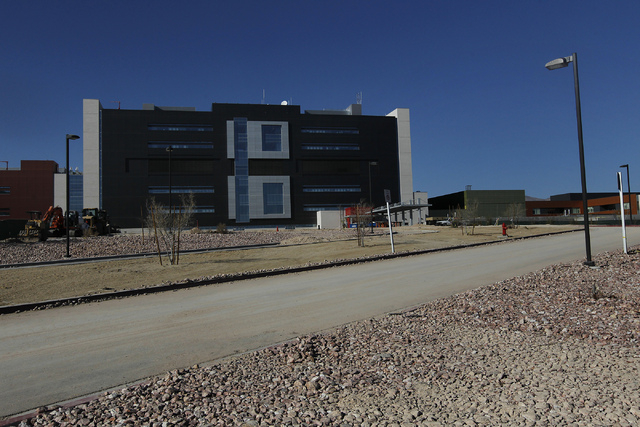VA secretary: Agency knew during construction that Nevada ER was too small



WASHINGTON — The Department of Veterans Affairs realized that the emergency room of its $585 million hospital in North Las Vegas would be too small but decided to finish the project and go back and fix it later, VA Secretary Eric Shinseki told Congress on Thursday.
The original hospital design envisioned it as a partner with the O’Callaghan Federal Medical Center at Nellis Air Force Base, where many Southern Nevada veterans had been receiving care. But “somewhere along the way,” he said, plans changed.
Once the VA facility was de-linked from Nellis, Shinseki said the agency became aware of its shortcomings but decided to move forward.
“We put it up because the overall plan was good,” the Obama administration official said. “We knew when we did that we would have to go back and make the emergency room a little larger. Don’t like doing that but in this case it was better to get the hospital up and taking care of veterans and make the adjustment.”
The hospital opened in August 2012, but has received mixed reviews from veterans. Work has been underway for several weeks on an emergency room expansion project costing more than $16 million. It will add 14 beds to the 11 that are already part of the hospital, for a total of 25 emergency beds.
Shinseki’s disclosure comes as questions are being raised by veterans and hospital staff about construction and operation of the facility which has a price tag of $1 billion counting equipment, furnishings and staff as well as building costs. Nevada members of Congress said Thursday they are ramping up their oversight of the facility.
Sen. Dean Heller, R-Nev., who sits on the Senate Committee on Veterans Affairs, said Thursday he has assigned staff to “figure out what is going on over there.”
The emergency room face-lift is causing a shuffle at the hospital.
Photographs obtained by the Review-Journal show that in December the double-doors to the ambulance bay for receiving trauma patients were blocked by chairs for patients. By January the doors had been boarded over but the chairs remained.
VA spokesman Richard Beam, however, said the ambulance entrance “has been walled since mid-July and will remain so through the construction process.”
“The space in the picture was temporarily reconfigured to accommodate a secondary waiting area that is designed for patients that have already been triaged (in a private room), but need additional diagnostic procedures to determine the next course of medical treatment,” Beam said in a statement.
Despite construction, “a temporary ambulance drop has been established just adjacent to the Emergency Department and is 100 percent operational with no reported issues from transport companies,” Beam said.
At Thursday’s hearing, Shinseki was questioned by Rep. Dina Titus, D-Nev. He said the project already was underway when President Barack Obama came into office, and could not explain why the requirements changed.
Following the House committee hearing, Titus said she had other questions as well and requested a meeting with Dr. Robert Petzel, the agency’s top medical official.
“It’s not just the size of the hospital that’s the problem,” Titus said. She added she has heard reports that raise questions about how the facility is staffed and its hiring practices. She said she will meet with emergency room doctors when she is in Las Vegas next week.
Nevada’s senators also are seeking information about the operations of the facility. Sen. Harry Reid, D-Nev., sent a letter to Shinseki this week on issues that have come to his attention, his spokeswoman said without elaborating.
In an interview Monday, former Rep. Shelley Berkley, D-Nev., who was a driving force for constructing the VA Medical Center and considers it her “one seminal achievement,” described three “glitches” in the hospital’s design:
• The emergency room was too small to handle the number of veterans who use it;
• The kidney dialysis area was originally configured in a “dog leg” so that not all patients could be observed by a nurse at the same time;
• And, the long-term care facility was built but not open for veterans’ use because staff and administrators are occupying it until the administration building is constructed.
“Is it perfect? No. Should they have built the emergency room larger? Yes,” she said.
Berkley said she has met with VA Southern Nevada Healthcare System Director Isabel Duff as recently as last week and has been assured that “within a year, all of these glitches will be solved.”
“Why it was that way? I don’t know that. I do know that the current administration there is remedying all of these problems as quickly as they can,” Berkley said. “And if they’ve got 80 percent of it operating beautifully and 20 percent needs work, I’ll take that 20 percent to no hospital at all.”
Beam has said the emergency room was based on the workload and funding that was available at the time construction began.
But since the medical center’s inception, the number of potential veterans projected to use the center after it opened has remained constant at about 60,000 annually.
Eleven days before the medical center opened in 2012, then-Director John Bright said the $1 billion complex — which includes roughly $600 million for medical center construction and $400 million for equipment, staffing and satellite clinics — serves about 46,000 veterans. Bright had sought more money for emergency room beds, but Congress didn’t approve his request.
He said that when the 90-in-patient-bed hospital and 120-bed nursing home care facility are fully operational, they would serve about 60,000 veterans. That was based on the 2010 census when the VA set Nevada’s veterans population at more than 234,000 with most — 164,225 — living in the Southern Nevada service area, including Nye and Lincoln counties.
That was consistent in 2004 when 41,000 veterans were enrolled for health care in the Las Vegas area and a VA study projected at least 63,000 would seek medical care by 2012.
Contact Stephens Washington Bureau Chief Steve Tetreault at stetreault@stephensmedia.com or 202-783-1760. Follow him on Twitter @STetreaultDC. Contact reporter Keith Rogers at krogers@reviewjournal.com or 702-383-0308. Follow him on Twitter @KeithRogers2.












